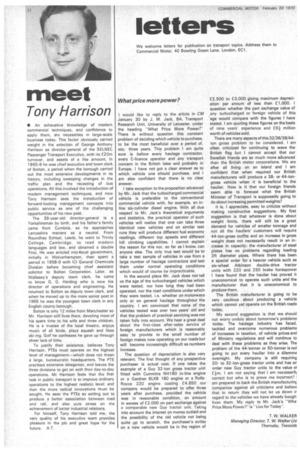letters
Page 34

If you've noticed an error in this article please click here to report it so we can fix it.
We welcome letters for publication on transport topics. Address them to Commercial Motor, 40 Bowling Green Lane, London, Ed.
What price more power?
I would like to reply to the article in CM January 30 by J. M. Jack, BA, Transport Research Unit, University of Leicester, under the heading "What Price More Power?" There is without question this constant problem of deciding which vehicle to purchase, to be the most beneficial over a period of, say, three years. This problem I am quite sure is before every haulage contractor, every C-licence operator and any transport concern in the British Isles and probably in Europe. I have not got a clear answer as to which vehicle one should purchase, and I am also confident that there is no clear answer.
I take exception to the proposition advanced by Mr. Jack that the turbocharged commercial vehicle is preferable to the conventional commercial vehicle with, for example, an inline six-cylinder diesel engine. With all due respect. to Mr. Jack's theoretical arguments and statistics, the practical operator of such vehicles will realize that one can take three identical new vehicles and on similar test runs they will produce different fuel economy readings, different top speeds and different hill climbing capabilities. I cannot explain the reason for this nor, so far as I know, can anyone else. The only true test would be to take a test sample of vehicles in use from a large number of haulage contractors and test them under normal operating conditions which would of course be impracticable.
In the second place Mr. Jack does not tell us the age of the turbocharged vehicles which were tested, nor how long they had been operated, nor the road conditions under which they were tested, i.e. whether on motorways only or on general haulage throughout the country. I am convinced that none of the vehicles tested was over two years' old and that the problem of practical servicing was not taken fully into account. We hear a great deal about the first-class after-sales service of foreign manufacturers which is reasonably easy to provide to the small number of foreign makes now operating on our roads but will become increasingly difficult as numbers increase.
The question of depreciation is also very relevant. The first thought of any prospective purchaser is actual cost. If one takes the example of a Guy 32-ton gross tractor unit fitted with Cummins NH 180 in-line engine or a Gardner 61.AB 180 engine or a RollsRoyce 220 engine costing £4,850 our company would be prepared to offer three years after purchase, provided the vehicle was in reasonable condition, an amount in excess of £2,000 on part exchange against a comparable new Guy tractor unit. Taking into account the interest on money outlaid and the possibility of the old vehicle not being quite ,up to scratch, the purchaser's outlay on a new vehicle would be in the region of £2,500 to £3,000 giving maximum depreciation per annum of less than £1,000. I question whether the part exchange value of any turbocharged or foreign vehicle of this age would compare with the figures I have stated. I am quoting these figures on the basis of nine years' experience and £6 million worth of vehicles sold.
There are many aspects of this 32/36/38/44ton gross problem to be considered. I am often criticized for continuing to wave the British flag but I cannot accept that our Swedish friends are so much more advanced than the British motor corporations. We are after all living on an island and I am confident that when required our British manufacturers will produce a 38or 44-tongross vehicle when it is beneficial to the haulier. How is it that our foreign friends seem able to forecast what the British Minister of Transport is supposedly going to do about increasing permitted weights?
It is, I appreciate, easy to criticize without making constructive suggestions. My first suggestion is that whatever is done about weight limits, there will still be a great demand for vehicles of smaller tonnage and not all the hauliers' customers will require 44-ton-gross outfits and an increase in gross weight does not necessarily result in an increase in capacity: the manufacturer of steel plates has no problems regarding loading 2ft diameter pipes. Where there has been a special order for a heavier vehicle such as six-wheel Atkinson double-drive tractor units with 220 and 250 brake horsepower I have found that the haulier has proved it uneconomical to operate such units and the manufacturer that it is uneconomical to produce them.
The British manufacturer is going to be very cautious about producing a vehicle which cannot yet operate on the British roads today.
My second suggestion is that we should not worry unduly about tomorrow's problems today. The haulage industry has faced, tackled and overcome numerous problems of increases in taxation, of vehicle prices and of Ministry regulations and will continue to deal with these problems as they arise. The problem of the 44-tonner or 50-tonner is no1 going to put every haulier into a dilemma overnight. My company is still requiring 20to 32-ton-gross tractor units and has or order new Guy tractor units to the value al Elm. I am not saying that I am necessarily correct but who is to prove me incorrect? am prepared to back the British manufacturinc companies against all criticisms and believE that in return they will not let us down ir regard to the vehicles we have already bough from them. My reply to Mr. Jack's "Wha Price More Power?" is Live for Today".
T. W. WALKER Managing Director, T. W. Walker Lta Thornaby, Teesside














































































































































































































